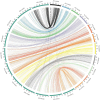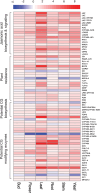Genome and Tissue-Specific Transcriptome of the Tropical Milkweed (Asclepias curassavica)
- PMID: 40103632
- PMCID: PMC11914377
- DOI: 10.1002/pld3.70031
Genome and Tissue-Specific Transcriptome of the Tropical Milkweed (Asclepias curassavica)
Abstract
Tropical milkweed (Asclepias curassavica) serves as a host plant for monarch butterflies (Danaus plexippus) and other insect herbivores that can tolerate the abundant cardiac glycosides that are characteristic of this species. Cardiac glycosides, along with additional specialized metabolites, also contribute to the ethnobotanical uses of A. curassavica. To facilitate further research on milkweed metabolism, we assembled the 197-Mbp genome of a fifth-generation inbred line of A. curassavica into 619 contigs, with an N50 of 10 Mbp. Scaffolding resulted in 98% of the assembly being anchored to 11 chromosomes, which are mostly colinear with the previously assembled common milkweed (A. syriaca) genome. Assembly completeness evaluations showed that 98% of the BUSCO gene set is present in the A. curassavica genome assembly. The transcriptomes of six tissue types (young leaves, mature leaves, stems, flowers, buds, and roots), with and without defense elicitation by methyl jasmonate treatment, showed both tissue-specific gene expression and induced expression of genes that may be involved in cardiac glycoside biosynthesis. Expression of a CYP87A gene, the predicted first gene in the cardiac glycoside biosynthesis pathway, was observed only in the stems and roots and was induced by methyl jasmonate. Together, this genome sequence and transcriptome analysis provide important resources for further investigation of the ecological and medicinal uses of A. curassavica.
© 2025 The Author(s). Plant Direct published by American Society of Plant Biologists and the Society for Experimental Biology and John Wiley & Sons Ltd.
Conflict of interest statement
The authors declare no conflicts of interest.
Figures









Similar articles
-
The Effects of Milkweed Induced Defense on Parasite Resistance in Monarch Butterflies, Danaus plexippus.J Chem Ecol. 2018 Nov;44(11):1040-1044. doi: 10.1007/s10886-018-1007-4. Epub 2018 Aug 20. J Chem Ecol. 2018. PMID: 30123937
-
Host Plant Species Influences the Composition of Milkweed and Monarch Microbiomes.Front Microbiol. 2022 Feb 24;13:840078. doi: 10.3389/fmicb.2022.840078. eCollection 2022. Front Microbiol. 2022. PMID: 35283842 Free PMC article.
-
Potent Nitrogen-containing Milkweed Toxins are Differentially Regulated by Soil Nitrogen and Herbivore-induced Defense.J Chem Ecol. 2024 Nov;50(11):725-737. doi: 10.1007/s10886-024-01546-2. Epub 2024 Oct 29. J Chem Ecol. 2024. PMID: 39467962
-
Climate change and an invasive, tropical milkweed: an ecological trap for monarch butterflies.Ecology. 2018 May;99(5):1031-1038. doi: 10.1002/ecy.2198. Epub 2018 Apr 4. Ecology. 2018. PMID: 29618170
-
Anthropogenic Impacts on Mortality and Population Viability of the Monarch Butterfly.Annu Rev Entomol. 2018 Jan 7;63:277-302. doi: 10.1146/annurev-ento-020117-043241. Epub 2017 Oct 4. Annu Rev Entomol. 2018. PMID: 28977776 Review.
Cited by
-
Identification of UDP-dependent glycosyltransferases in the wallflower cardenolide biosynthesis pathway.J Biol Chem. 2025 Jun;301(6):108565. doi: 10.1016/j.jbc.2025.108565. Epub 2025 Apr 30. J Biol Chem. 2025. PMID: 40316018 Free PMC article.
References
-
- Agrawal, A. A. 2017. Monarchs and Milkweed: A Migrating Butterfly, a Poisonous Plant, and Their Remarkable Story of Coevolution. Princeton, NJ: Princeton University Press.
-
- Alexa, A. , and Rahnenfuhrer J.. 2023. “topGO: Enrichment Analysis for Gene Ontology.”
LinkOut - more resources
Full Text Sources
Miscellaneous

